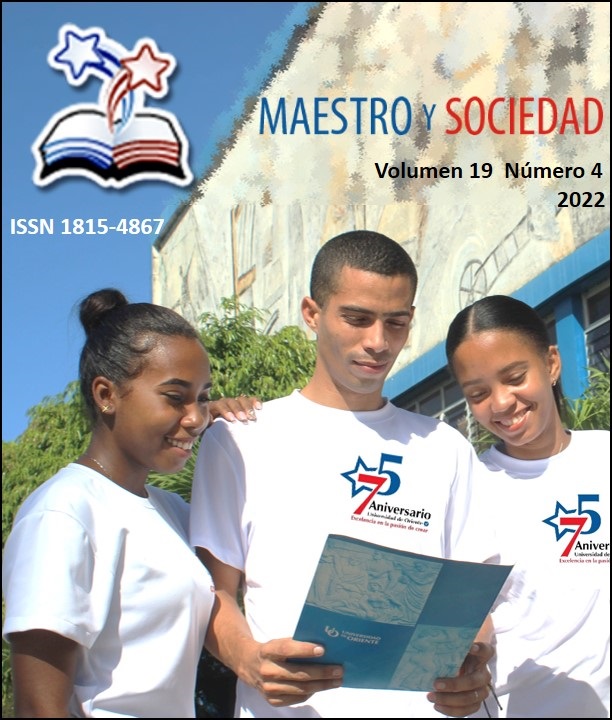Educational app as a pedagogical tool to promote good eating habits in schoolchildren in the Bolívar canton
Educational app as a pedagogical tool to promote good eating habits in schoolchildren in the Bolívar canton
Keywords:
educational mobile application, eating habits, pedagogical tools, Nutrition GameAbstract
This research aims to enrich learning environments in children, new technologies and media in education are valuable tools to undertake changes and innovations that have an impact on the formation of children, games in education aim to help children students to remember what they have learned, since active participation fosters knowledge, there is an urgent need to have innovative proposals that contribute to improving the quality of life of human beings and renew the contents that respond to the problem of bad habits food. Objective: to create a mobile application that makes it easier for children to learn about the origin and effect on their body of the foods they usually consume. The educational mobile application was created as friendly pedagogical tools to take advantage of attention and teach the child while having fun, considering the knowledge included in the content they are consuming.
References
Arancibia, M., Soto, C. P. y Contreras, P. (2010). Concepciones del profesor sobre el uso educativo de las tecnologías de la información y la comunicación (TIC) asociadas a procesos de enseñanza-aprendizaje en el aula escolar. Estudios pedagógicos (Valdivia), 36(1), 23-51.
Barberá Cebolla, J. P. y Fuentes Agustí, M. (2012). Estudio de caso sobre las percepciones de los estudiantes en la inclusión de las TIC en un centro de educación secundaria. Profesorado, 16(3), 285-305. http://hdl.handle.net/10481/23110
Cabero, J. (2010). Los retos de la integración de las TIC´s en los procesos educativos, Límites y posibilidades, Perspectiva Educacional. Formación de Profesores, 49(1), 32-61.
De la Hoz, E. (2013). Innovación desde lo virtual: las TIC y su poder de transformación en las nuevas formas de enseñar y aprender en la Universidad de la Costa. Tercera Conferencia de Directores de Tecnología de Información, TICAL 2013.
De Oliveira, S., y Sousa, K. (2008). Novas perspectivas em educação alimentar e nutricional. Psicol. USP. 19(4), 495-504. http://pepsic.brsalud.org/scielo.php?scrip=sci_artlext&pid=51678-51772008000400008&lng=en&nrm=iso
FAO. (2017). Food and Agriculture Organization of the United Nations. Second International Conference on Nutrition. http://www.fao.org/3/a-ml542e.pdf
Freire, W., Ramirez, M., Belmont, P., Mendieta, M., Silva, K., Romero, N., Saénz, K., Piñeiros, P., Gómez, L., Monge, R. (2014). Encuesta Nacional de Salud y Nutrición. (Tomo I). UNICEF, OPS/OMS, UNFPA.
Godoy, A. y Barbosa, F. (2010). Game-Scrum: An Approach to Agile Game Development. Proceedings of SBGames.
ISEA S. Coop. (2009). Mobile learning, análisis prospectivo de las potencialidades asociadas al Mobile Learning. http://www.iseamcc.net/eISEA/Vigilancia_tecnologica/informe_4.pdf
Letelier, P. y Penadés, M. (2012). Metodologías ágiles para el desarrollo de software: Xtreme Programming (XP). (s.e.).
Martínez Álvarez, M., et al. (2016). Influencia de los hábitos de ocio sedentario en el desarrollo de sobrepeso y obesidad en una población de escolares. NURE Investigación, 14(87). http://www.nureinvestigacion.es/OJS/index.php/nure/article/view/1081
MavelApp. (2020). Marvel: la plataforma de diseño para productos digitales. https://marvelapp.com/
McCoy, D. C., Peet, E. D., Ezzati, M., Danaei, G., Black, M. M., Sudfeld, C. R., Fawzi, W. y Fink, G. (2016). Early childhood developmental status in low- and middle-income countries: National, regional, and global prevalence estimates using predictive modeling. PLOS Medicine, 13(6). http://journals.plos.org/plosmedicine/article/asset?id=10.1371%2Fjournal.pmed.10 02034.PDF
Nour, S. M. (2013). Education, Training and Skill Development Policies in Sudan: Macro-Micro Overview. 10.1007/978-3-642-32811-4_9
Organización Mundial de la Salud. (2017). Temas de Nutrición. http://www.who.int/nutrition/topics/moderate_malnutrition/es/.
Ramos, A. & Herrera, M. (2009). Desarrollo de habilidades cognitivas con aprendizaje móvil: un estudio de casos. Revista Comunicar, 18(2010), 201-209. http://www.redalyc.org/articulo.oa?id=15812481023
Sala M., C. B. (2013). El Uso Didáctico de las Tecnologías de la Información y la Comunicación (TIC) en la Práctica Docente de la Licenciatura en Pedagogía del Sistema de Universidad Abierta y a Distancia (SUAyED) de la UNAM. Revista Amicus Curiae, 2(1).
Sosa Zamora, M., Suárez Feijoo, D., González Pereira, S., Otero Mustelier, Á. y Céspedes García, S. (2015). Caracterización de niños de hasta 9 años con desnutrición proteico energética. MEDISAN, 19(2), 180-185.
Trindade, V. y Torillo, D. (2016). La entrevista no estructurada en sectores de actividades informales: obstáculos y facilitadores. V Encuentro Latinoamericano de Metodología de las Ciencias Sociales (ELMeCS).
Tutorialspoint. (2015). SDLC-Modelo ágil. https://www.tutorialspoint.com/sdlc/sdlc_agile_model.htm. [Consultado: 06-feb-2020].
Unesco. (2012). La Unesco coordina el debate sobre el aprendizaje mediante dispositivos móviles en el Foro de la Cumbre Mundial sobre la Sociedad de la Información. http://www.unesco.org/new/es/education/resources/online-materials/singleview/news/unesco_leads_discussion_on_mobile_learning_at_wsis_forum/
UNICEF & GAIN. (2019). Food systems for children and adolescents. UNICEF.
UNICEF. (2005). Los objetivos de desarrollo del milenio tienen que ver con la infancia. UNICEF.
UNICEF. (2014). Encuesta Nacional de Salud y Nutrición ENSANUT-ECU-2012. (Tomo I). UNICEF, OPS/OMS, UNFPA; 2014. 718 p.
Yunda, O. (2017). Importancia de UML (Lenguaje de modelado unificado). Scribd.
Zempoalteca, B., Barragán, J. F., González, J. y Guzmán, T. (2017). Formación en TIC y competencia digital en la docencia en instituciones públicas de educación superior. Apertura, 9(1), 80-96.
Published
How to Cite
Issue
Section
License
Copyright (c) 2022 Ligia E. Zambrano-Solórzano , Rosa V. González-Zambrano , Denise Ilcen Contreras Zapata , Lourdes M. Crespo Zafra

This work is licensed under a Creative Commons Attribution-NonCommercial-NoDerivatives 4.0 International License.
This journal provides immediate open access to its content, based on the principle that offering the public free access to research helps a greater global exchange of knowledge. Each author is responsible for the content of each of their articles.



























 Universidad de Oriente
Universidad de Oriente 